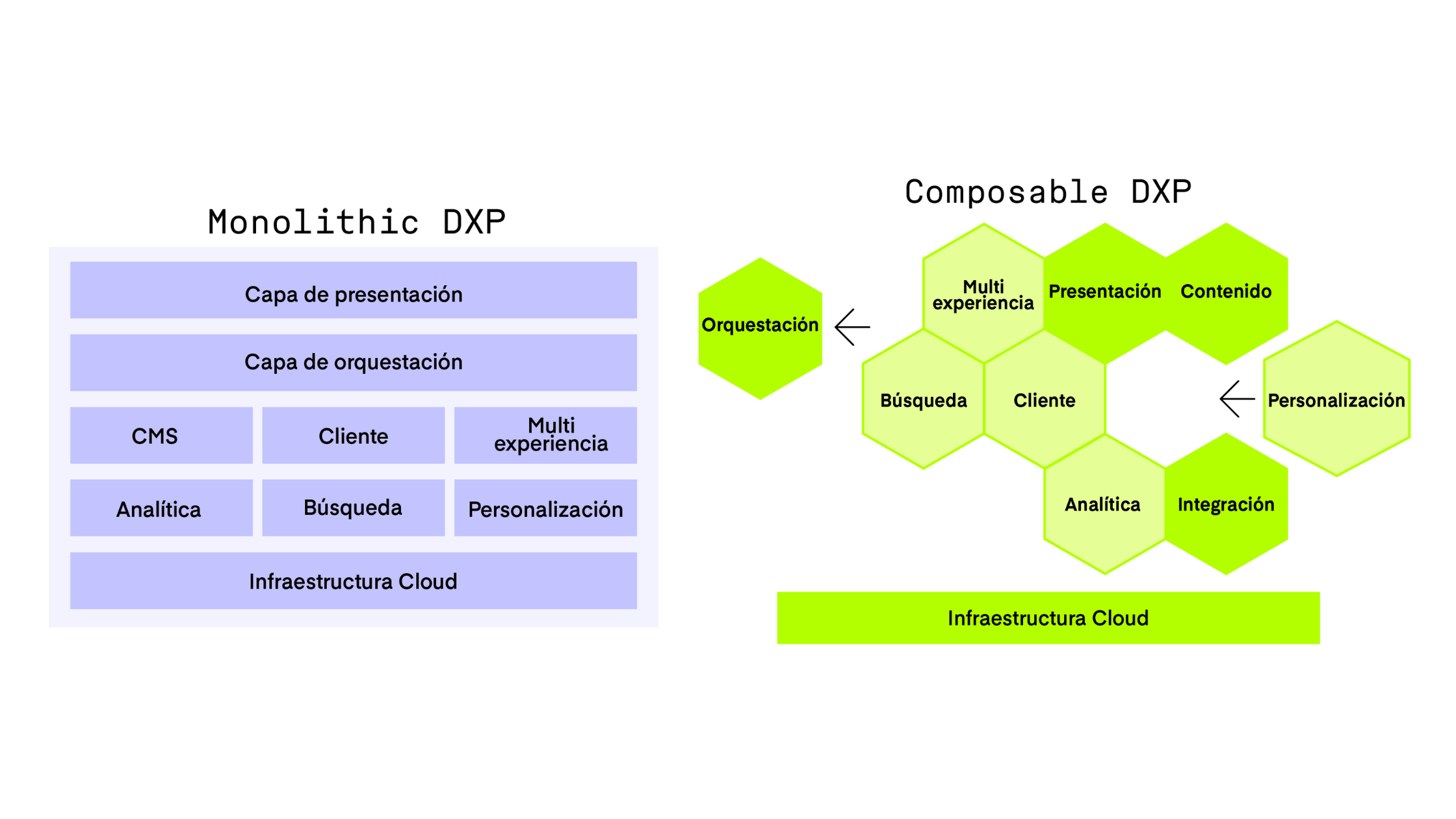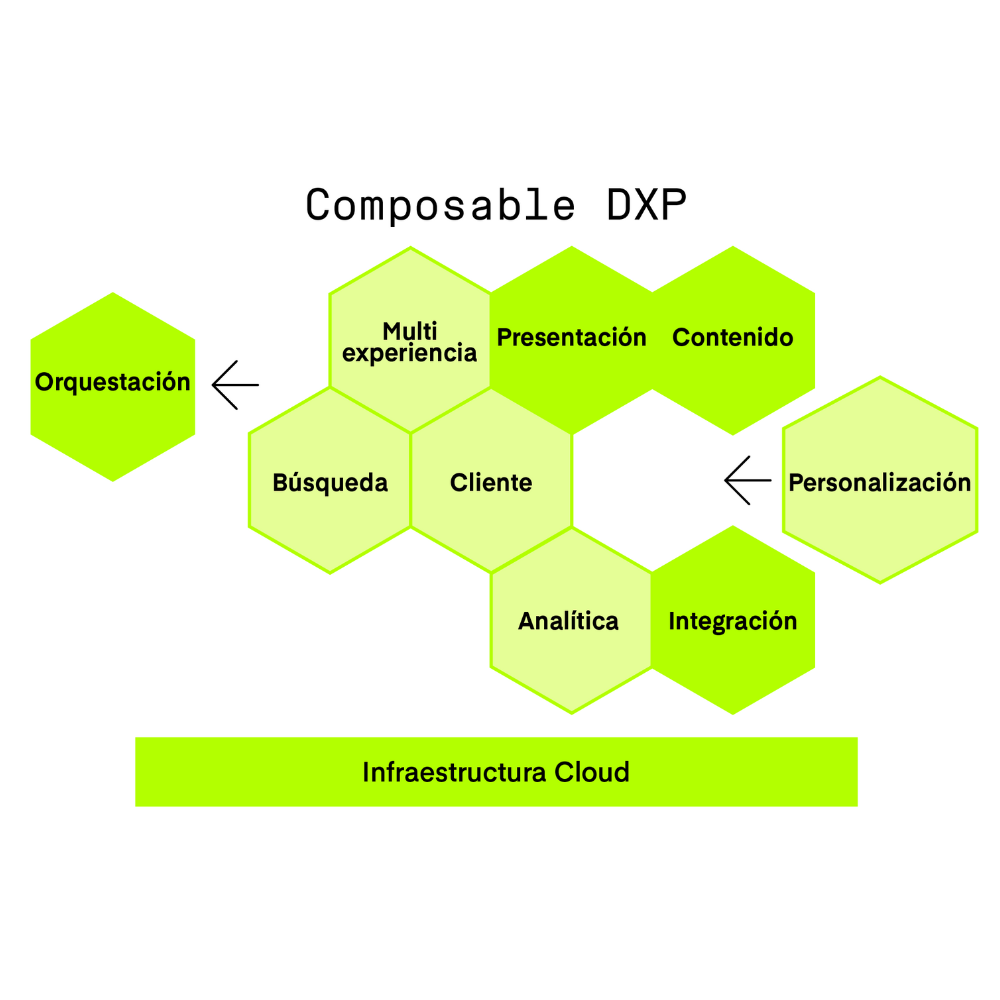What is a Composable DXP and what are its advantages?

A Composable DXP is a digital experience platform that allows the integration of best-of-breed technologies through APIs and microservices.
As your digital platform grows, your technical needs increase. Your company may have started with a custom-made website, then installed a CMS. Later, you may have decided to integrate an analytics solution and eventually implemented a complete marketing suite.
However, the market evolves and you must adopt the best and latest technologies.
This is the normal process of growth and development of a digital platform. However, every time you integrate a new technology, the process is slow and costly. Despite this, your company needs to make updates to stay ahead technologically and meet the needs of today's digital consumers.
In a digital world that moves so fast, how can your company move at the same speed and deliver a great experience to its users?
Composable DXP offers a solution to this problem. But first, we need to understand what a DXP is.
What is a DXP?
DXP stands for Digital Experience Platform, which is essentially the evolution of traditional CMSs.
A CMS essentially provides the necessary tools to create new content within a website or mobile application.
Meanwhile, a DXP is a complete solution that provides intelligent automation and delivery across websites and portals, applications, or IoT devices. They have built-in tools such as a search engine, personalization engine, analytics, omnichannel capabilities, user database, or A/B testing.
Now that we have clarified what a DXP is, it is important to establish the differences between a Monolithic DXP and a Composable DXP.
What is a Monolithic DXP?
A Monolithic DXP is a unified platform in which new technologies cannot be integrated.
The front end and back end are completely joined together. Each of the layers, tools, and technologies is integrated and belongs to a single vendor. This means that if a part of your platform is not working, you cannot change or replace it.

Most small and medium-sized businesses use a Monolithic DXP because it was part of their existing technology stack and they have not bothered to switch to a more modern solution.
The problem with this type of solution is that it becomes too difficult to make any changes to your platform. Whether you want to change the interface design, improve the search engine, or integrate new technology, it becomes a headache for the development and testing team.
Making these changes will consume many resources and time from your team, and you may even find that your DXP simply does not allow you to make the improvement your platform needs.
And when you do not continuously improve your platform, you stay away from the expectations of today's digital users, putting you at a disadvantage in the market and with your competitors.
Composable DXPs come to offer a solution to these problems.
What is a Composable DXP?
A Composable DXP is a platform that allows the integration of multiple technologies through APIs and microservices. This way, your company can make substantial changes to the user experience quickly and easily.
Composable DXP can be seen as a puzzle, where you can replace pieces of your site. If you don't like how a part of your platform is working, you can simply remove that piece and replace it with a specialized technology in the market.

Whether you want to change the search engine, personalization engine, database, analytics, or the front-end of your site to another technology, you can achieve this through a Composable DXP.
For example, if you feel that the search engine on your site is not good enough, you can remove the search engine from your DXP and replace it with a better search engine like Algolia.
Advantages of Composable DXP over Monolithic DXP
Create omnichannel experiences
A composable DXP uses APIs to connect with multiple channels (website, mobile app, or IoT devices), enabling your company to create omnichannel experiences.
This allows your company to meet basic demand and stand out by launching consistent campaigns that support the digital experience across all platforms.
Improve your user experience
Monolithic systems make it difficult to collect information from multiple channels, adopt and integrate information with modern reporting and analytics tools, and integrate automated marketing tools.
The data from your platform is key to delivering better personalized experiences to users, and Monolithic DXPs do not allow you to take quick actions to achieve this.
With a Composable DXP, you can integrate key analytics and reporting for your business. This allows you to gather better insights into how your users navigate your platform, optimize the digital experience of your site, and deliver personalized experiences.
Businesses that adapt the customer journey according to analytics are the ones that excel.
Develop your platform more simply and quickly
Monolithic DXPs are often a problem for programmers.
This is because monolithic structures do not allow the use of current frontend frameworks. In addition, monolithic DXPs have very rigid templates that make it harder to adopt different or creative technical approaches. This inhibits the creativity of programmers and reduces development speed.
On the other hand, Composable DXPs allow you to make changes simply. You can connect touchpoints or channels using existing APIs, build personalized experiences, test multiple marketing campaigns, gain insights, and generate results.
By developing digital products quickly, you will stay ahead of your competition.
Facilitate scalability
Companies are always looking to grow. In a Monolithic DXP, the more software applications, sites, or editors you integrate into your platform, the more overload problems you will suffer.
A Composable DXP allows you to grow without limiting yourself. You can implement changes in less time, launch new campaigns, and adopt new technologies.
Integrate the best solutions into your technology stack
A Monolithic DXP does not allow you to integrate the best solutions into your platform. But in a Composable DXP, you have the ease of integrating new technologies that fit your needs, allowing you to stay at the level of your users' expectations.
As you can see, a Composable DXP has multiple advantages over a Monolithic DXP.However, this software architecture is not for all companies.
A composable architecture has its own technical complexity. In addition, carrying out this implementation takes time, money, and resources. It is important to know if your company is in the right place to carry it out.
You don't depend on a single manufacturer
One of the great advantages of a Composable architecture is that the development of your platform does not depend on a single manufacturer. At the moment a solution is no longer useful within your technology stack, you can remove it and replace it with a new technology.
For which companies does a Composable DXP make sense?
Your company is ready for a Composable DXP if it has sufficient technological maturity, a team with internal or external capabilities to achieve it, and a culture oriented towards improving the user experience.
Technological maturity
Your company should already have a digital product built on a foundation and have executed digital projects before. Building a Composable DXP from scratch requires a lot of processes and technical knowledge to make it a reality.
Development team
To implement a Composable DXP architecture, you need an internal programming team to develop the system at the code level. Another option is to hire an external software agency to help you build your Composable DXP and install the best technologies for your site.
Culture oriented towards the user experience
Composable DXP only makes sense if you have a great team of developers, marketers, and designers ready to exploit each of the functionalities of your technological stack. A great tool is useless if you don't have a team ready to use it.
Ask yourself, is my team capable of taking advantage of all the tools available in a DXP? This means search, analytics, CMS, personalization, email marketing, A/B testing, and more.
Important considerations for implementing a Composable DXP
Developing a composable product is a lengthy process of reconstruction. It's not about throwing everything away and starting from scratch. The goal is to decompose the old system while integrating the new pieces of your product.
This process can only be achieved if decision-makers are focused on having the right people, developing better processes, and using the right technologies.
Develop your team
In the development of a Composable DXP, you don't need people who know about all technologies. Each member of your team can specialize in a specific technology. This means you should hire people who are experts in the technology you want to implement or develop your own people to become experts.
You will need the right mix of backend developers, frontend developers, testers, and analysts who can maximize the functionality of each new technology in your stack.
Think about omnichannel experiences
Usually, companies think about a single website or a single mobile app. However, to develop composable products, your team will have to change its mindset. They will now have to visualize the experience of different channels as only one user experience.
Implement Composable UX
The three main components of a DXP are content management, personalization, and presentation. The first step for a composable architecture is to stop seeing the platform as an immovable monolith and start seeing it as a series of components that can be removed, replaced, and improved.
The next big step will be to implement composable UX. In this stage, interfaces and experiences can be created by the marketing team without the need for technical knowledge.
Select the best DXP for you
In the market, there are multiple options for a DXP that are designed to develop composable architectures. Some options are Magnolia, Acquia, or Drupal.
You should analyze the advantages and disadvantages of each of them to select the best option for your business.


